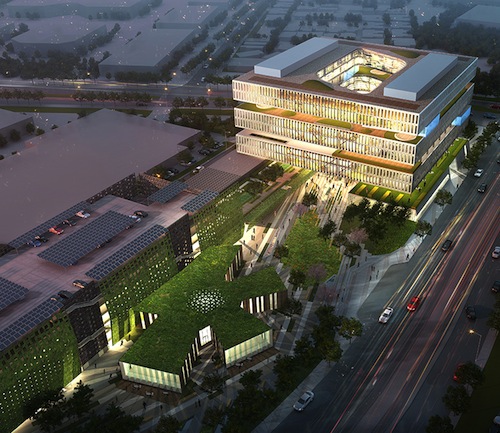Samsung Electronics will enter the Silicon Valley rivalry for best technology-oriented campus with its new headquarters design. The 1.1 million-sf San Jose campus, calculated to give Apple, Facebook and other local high-tech firms a run for their architectural money, will support at least 2,500 sales and R&D staff in Samsung's semiconductor and display businesses.
A pair of linked, 10-story office buildings, encompassing a combined 680,000 sf, will be the hallmark structure. Extensive "green floors" will be provided on every third story, creating a stack of alternating enclosed and open spaces. The gardens will be available to employees for informal breaks and organized recreation. Adjacent facilities will be connected by elevated walkways.
In addition to offices, the program includes research space, a cleanroom, a data center, basketball and sports courts, and cafés in a star-shaped amenities building. A parking structure for more than 1,500 vehicles will feature a rooftop solar array. NBBJ, also the architect behind the recently announced Google Bay View campus, is helming the project.
Samsung Information Systems America is getting new quarters as well. The company has signed a 15-year lease for two six-story buildings in Mountain View's Cypress Business Park, comprising about 385,000 sf.
The state of California is providing an R&D tax credit and an unspecified reimbursement for employee training. The city of San Jose is pitching in with a reduction of traffic impact fees (by more than 50%), a 75%+ reduction in construction taxes, a 50% rebate of up to half of utility taxes for 10 years, and a direct $500,000 economic incentive.
(http://articles.latimes.com/2013/feb/18/business/la-fi-samsung-silicon-valley-20130218)
Related Stories
| Oct 5, 2011
GREENBUILD 2011: Brick offers growing options for sustainable building design
Brick exteriors, interiors and landscaping options can increase sustainability that also helps earn LEED certification.
| Oct 5, 2011
GREENBUILD 2011: Roof hatch designed for energy efficiency
The cover features a specially designed EPDM finger-type gasket that ensures a positive seal with the curb to reduce air permeability and ensure energy performance.
| Oct 4, 2011
GREENBUILD 2011
Click here for the latest news and products from Greenbuild 2011, Oct. 4-7, in Toronto.
| Oct 4, 2011
GREENBUILD 2011: Methods, impacts, and opportunities in the concrete building life cycle
Researchers at the Massachusetts Institute of Technology’s (MIT) Concrete Sustainability Hub conducted a life-cycle assessment (LCA) study to evaluate and improve the environmental impact and study how the “dual use” aspect of concrete.
| Oct 4, 2011
GREENBUILD 2011: Johnsonite features sustainable products
Products include rubber flooring tiles, treads, wall bases, and more.
| Oct 4, 2011
GREENBUILD 2011: Nearly seamless highly insulated glass curtain-wall system introduced
Low insulation value reflects value of entire curtain-wall system.
| Oct 4, 2011
GREENBUILD 2011: Ready-to-use wood primer unveiled
Maintains strong UV protection, clarity even with application of lighter, natural wood tones.
| Oct 4, 2011
GREENBUILD 2011: Two new recycled glass products announced
The two collections offer both larger and smaller particulates.
| Oct 4, 2011
GREENBUILD 2011: Mythic Paint launches two new paint products
A high performance paint, and a combination paint and primer now available.
















